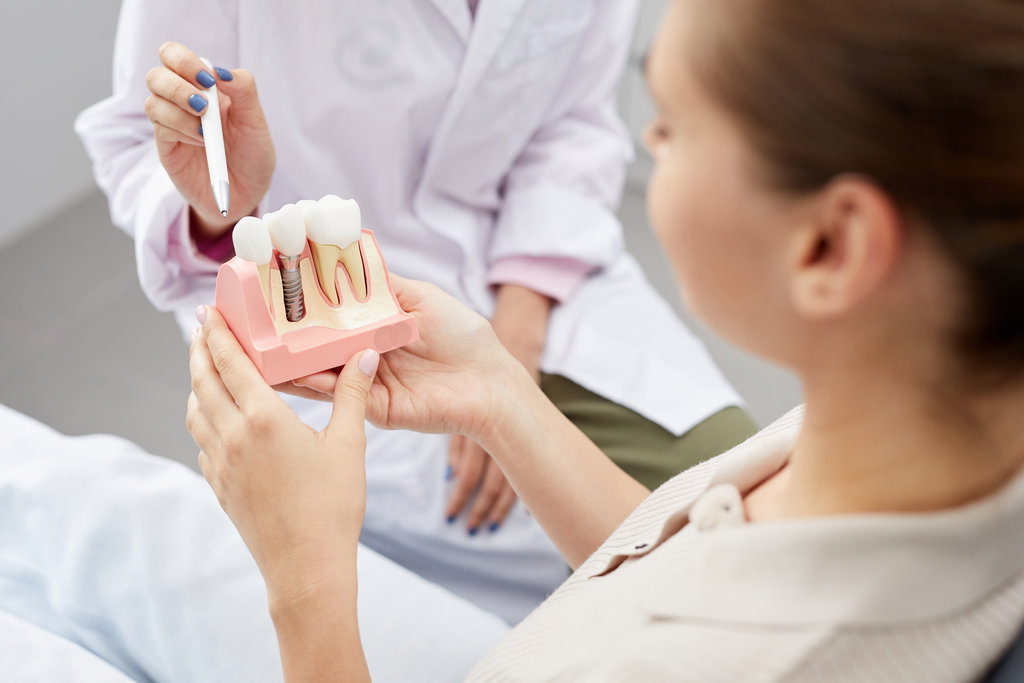
When facing the reality of tooth loss, the path forward can feel overwhelming with multiple restoration options presenting different advantages and considerations. Both dental implants and bridges offer proven solutions for replacing missing teeth, yet each approach addresses your unique dental needs through distinctly different methods and long-term outcomes.
Understanding your restoration options becomes much simpler when working with experienced prosthodontists who can evaluate your specific situation and guide you toward the most effective treatment. At our comprehensive dental practice, we help patients in Allen, Texas, make informed decisions about their oral health by explaining the benefits and considerations of each restoration method in detail.
How Dental Implants Work
Dental implants function as artificial tooth roots placed directly into your jawbone through a precise surgical procedure. Made from biocompatible titanium, these implants integrate with your bone tissue over several months through a process called osseointegration. Once fully healed, a custom crown attaches to the implant, creating a replacement tooth that looks, feels, and functions like your natural teeth.
The implant process typically requires multiple appointments over several months. After initial placement, your jawbone needs time to heal and fuse with the implant before receiving your final restoration. This healing period ensures a stable foundation for your new tooth.
Modern dental technology allows for precise implant placement and better treatment outcomes. Digital imaging and computer-guided surgery help ensure optimal positioning for both function and aesthetics.
Understanding Dental Bridges
Dental bridges replace missing teeth by connecting crowns to the teeth adjacent to the gap, called abutment teeth. The replacement tooth, known as a pontic, sits between these crowns and fills the space left by your missing tooth. This creates a “bridge” across the gap, hence the name.
Traditional bridges require reshaping the adjacent healthy teeth to accommodate the crowns. This irreversible process removes tooth structure but creates a stable foundation for your bridge. Alternative bridge designs, such as Maryland bridges, use metal or ceramic wings bonded to the back of adjacent teeth, preserving more natural tooth structure.
The bridge fabrication process typically takes two to three weeks after your initial preparation appointment. During this time, you wear a temporary bridge while your custom restoration is created in a dental laboratory.
Comparing Treatment Outcomes
When it comes to direct comparisons between the two treatment processes, consider the following:
Longevity and Durability
Dental implants often last 20 to 30 years or even a lifetime with proper care, making them the most durable tooth replacement option. The titanium implant becomes permanently integrated with your jawbone, providing exceptional stability and strength.
Bridges typically last 10 to 15 years before requiring replacement. The lifespan depends on your oral hygiene habits, the health of supporting teeth, and normal wear over time. Regular dental checkups help monitor bridge condition and address any issues early.
Bone Health Preservation
One significant advantage of dental implants involves preserving jawbone health. When you lose a tooth, the jawbone in area begins to deteriorate without the stimulation normally provided by tooth roots. Implants provide this stimulation, maintaining bone density and facial structure.
Bridges do not prevent bone loss in the area of the missing tooth. Over time, this bone resorption can affect your facial appearance and may complicate future dental treatments.
Impact on Adjacent Teeth
Dental implants stand independently without affecting neighboring healthy teeth. This preservation of natural tooth structure offers long-term benefits for your overall oral health.
Bridge placement requires altering adjacent teeth, which increases their risk of future dental problems. However, if these supporting teeth already need crowns due to decay or damage, a bridge may address multiple issues simultaneously.
Making the Right Choice for Your Situation
Several factors influence whether implants or bridges work better for your specific needs. Age, overall health, bone density, and the condition of surrounding teeth all play important roles in treatment planning. Your oral hygiene habits and commitment to maintenance also affect long-term success rates.
Financial considerations include both immediate costs and long-term value. While implants typically require a higher initial investment, their exceptional longevity often makes them more cost-effective over time. Many patients find the superior function and preservation of natural teeth worth the additional expense.
Dr. Peter Hazim: Your Trusted Choice for Dental Restorations
Since 1999, Dr. Peter Hazim has provided quality comprehensive dentistry and prosthodontic care to patients throughout Allen, Texas. As a certified prosthodontist with advanced training in restoring damaged or missing teeth, Dr. Hazim combines technical precision with compassionate care to help you achieve optimal oral health. His dedication to continuing education through prestigious institutions like the Spear Institute and Pankey Institute ensures you receive the most current and effective treatments available.Our multilingual team understands the importance of clear communication throughout your treatment process, ensuring you feel confident and informed about your dental care decisions. Dr. Hazim’s recognition as “Best Dentist in Dallas” by D Magazine from 2017 to 2022 reflects his commitment to exceptional patient care and clinical outcomes. Whether you need dental implants, bridges, or other restorative treatments, our practice provides comprehensive solutions to restore your smile’s function and beauty. Contact our office today at (972) 727-5599 or reach out through our contact form to schedule your consultation.

 972-727-5599
972-727-5599